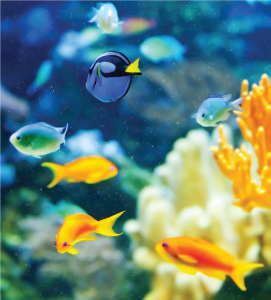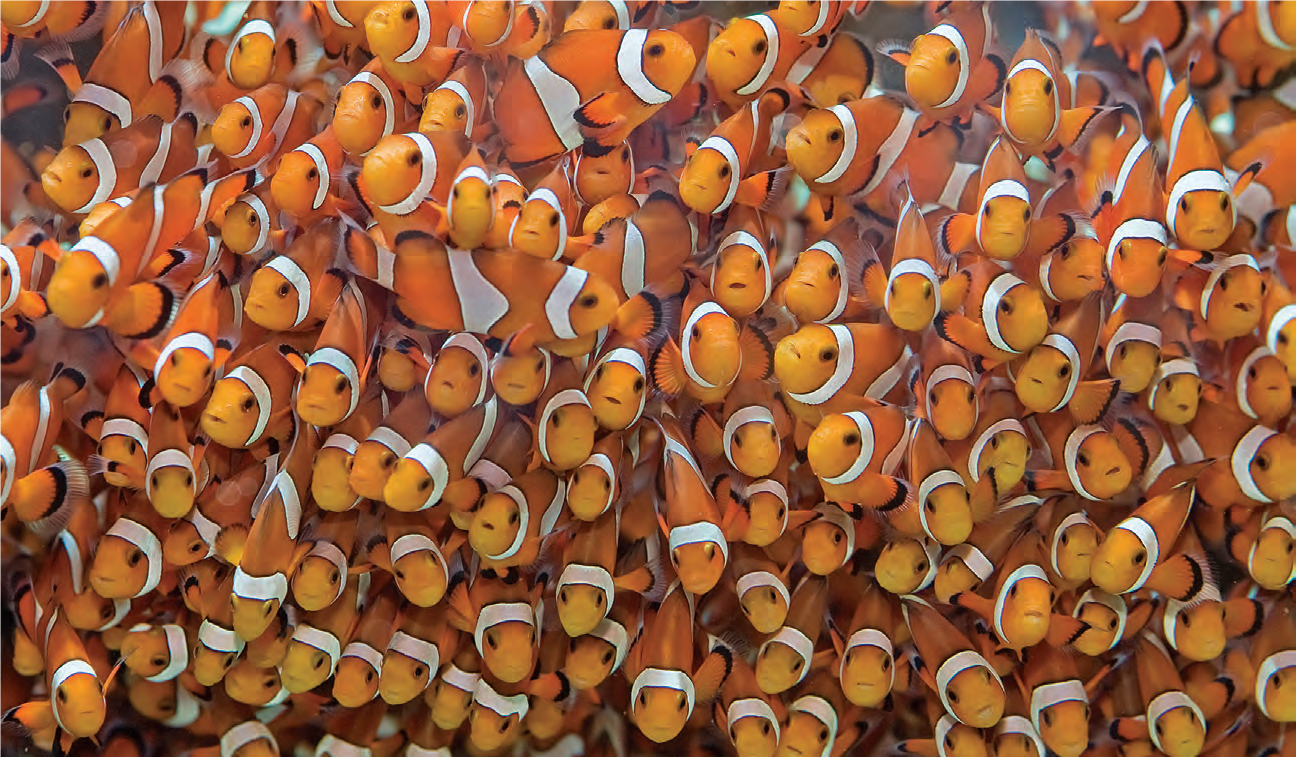Tank Girl
A (Saltwater) Fish Story Finding Nemo is not the problem. Keeping Nemo alive is.

How many finny lives are upon my head? As a writer and editor of reference books, magazine articles and web pages on the care and feeding of all manner of aquatic life, how many kids did I help to take that final, fatal step after Disney had entranced them with Finding Nemo? How many gazillion brave little Clownfish lives were sacrificed in the service of a silly fad…and what was my part in it? It breaks my heart. Even more distressing is the fact that I may be in the minority. The pet industry, with which I have been entangled, like fishing line around the foot, professionally as an aquatics editor the past 20 years (and personally as a hobbyist for over fifty), does not profit from our successes. It’s a paradox, and perhaps it carries a larger message to our critical selves:

Photo by Matt Wittenrich, courtesy of Jeff Turner Reef Aquaria Design
The industry that supplies the livestock and equipment for people who would like to enjoy a small slice of the coral reef in their homes and offices profits from the woes and disappointments of the average beginning aquarium fish hobbyist—particularly in the marine fish and invertebrate hobby. Does the average Joe (or Joanne) starting a saltwater tank stand a fighting chance? The short answer is Yes. The long answer is that keeping a successful marine aquarium is equal parts difficult and satisfying. I am here to tell you that it can be done…as long as you’re willing to keep your eyes and wallet open, and understand how this hobby actually works. I offer the following nuggets of wisdom to help the budding “tank girl” (or boy) build a foundation for success. • Captive-bred specimens are recommended for beginners in marine aquarium keeping, regardless of the species desired. Captive-bred animals are hardier, acclimated to aquarium living, and are virtually disease-free. Also, if your pet shop is selling captive-bred stock, you can generally assume that they actually give a hoot about the environment. • More expensive fish are generally in better shape than bargains. At the grocery store, wild-caught fish are more expensive and worth it. That’s because you are eating them. But in a good pet store, it’s the captive-bred fish that are more expensive. It’s counter-intuitive, I know, but please buy the expensive fish. In the end, the dead fish is the most expensive one of all. • The biology of the coral reef is as complicated as it is achingly beautiful. The ability to duplicate the ocean’s floor is a skill that comes with dedication, experience, and a whole lot of reading and working with other like-minded people. An honest pet industry professional will find some way to convey this point to you. A hard-nosed one won’t. That’s because the pet industry counts on the great turnover in hobbyists. All those glass boxes at garage sales represent money down the drain for overwhelmed or under-informed owners…and countless tiny lives flushed away. • Patience, patience and more patience. Don’t become a statistic. Start slow and keep it simple. Is it too much to ask that people not buy their first saltwater aquarium along with the fishes, live rock, and invertebrates all on their first visit to a pet shop? I experiment constantly, and found the very best aquarium I ever kept was limited to live rocks for a whole year before I put any fish in. I always tell my friends to “grow something” in the water first. No matter how many products are available to help start aquariums quickly, the aquarist’s best friend starting out is time. • Patronize the local brick & mortar pet shop and—I’ll say it again—beware of bargains. Even though it may not be able to compete with Internet prices, your local pet shop was likely opened as a labor of love and expertise; these folks are looking to make a living, not a fortune. Pet shop insiders will be the most generous of people with their time, experience, and good advice. However, be aware of the fishmonger who repeats whatever it is you just said, who agrees with a wayward premise. (Yeah! I always feed live guppies to all my cichlids.) If the advice smells like a bucket of week-old dead fish, this is what you’ll probably have next week if you buy from this guy. I only thank my lucky stars that Clownfish are now being commercially farmed at facilities like the ORA hatchery complex in Ft. Pierce, Florida and need not be collected from the wild. Had Nemo been an equally adorable Banggai Cardinalfish, collection pressures on the small wild populations would definitely have put this species at serious risk, even though it too is able to be bred in captivity; just not enough to supply the demand for fish that a movie like Nemo would generate. Although some of us in the industry wrestle with our consciences, in the end we believe that every person who begins a saltwater aquarium—regardless of the outcome— gains new respect and appreciation for our delicate planet. I can’t think of any other exercise that shows us in such acute detail just how difficult it can be to keep a small being living under our care. Perhaps if more people dedicated themselves to maintaining flourishing saltwater tanks, the Gulf of Mexico would still support a shrimping industry, global warming would be addressed in a more proactive way, and we would realize that the line between the coral reefs of Fiji and the Arthur Kill can be an astoundingly fine one. EDGE
Is it too much to ask that people not buy their first saltwater aquarium along with the fishes, live rock, and invertebrates all on their first visit to a pet shop? I experiment constantly, and found the very best aquarium I ever kept was limited to live rocks for a whole year before I put any fish in. I always tell my friends to “grow something” in the water first. No matter how many products are available to help start aquariums quickly, the aquarist’s best friend starting out is time. • Patronize the local brick & mortar pet shop and—I’ll say it again—beware of bargains. Even though it may not be able to compete with Internet prices, your local pet shop was likely opened as a labor of love and expertise; these folks are looking to make a living, not a fortune. Pet shop insiders will be the most generous of people with their time, experience, and good advice. However, be aware of the fishmonger who repeats whatever it is you just said, who agrees with a wayward premise. (Yeah! I always feed live guppies to all my cichlids.) If the advice smells like a bucket of week-old dead fish, this is what you’ll probably have next week if you buy from this guy. I only thank my lucky stars that Clownfish are now being commercially farmed at facilities like the ORA hatchery complex in Ft. Pierce, Florida and need not be collected from the wild. Had Nemo been an equally adorable Banggai Cardinalfish, collection pressures on the small wild populations would definitely have put this species at serious risk, even though it too is able to be bred in captivity; just not enough to supply the demand for fish that a movie like Nemo would generate. Although some of us in the industry wrestle with our consciences, in the end we believe that every person who begins a saltwater aquarium—regardless of the outcome— gains new respect and appreciation for our delicate planet. I can’t think of any other exercise that shows us in such acute detail just how difficult it can be to keep a small being living under our care. Perhaps if more people dedicated themselves to maintaining flourishing saltwater tanks, the Gulf of Mexico would still support a shrimping industry, global warming would be addressed in a more proactive way, and we would realize that the line between the coral reefs of Fiji and the Arthur Kill can be an astoundingly fine one. EDGE
Editor’s Note: Mary Ellen Sweeney is the ultimate Tank Girl—a lifelong hobbyist and a razor-sharp writer and editor for aquatics magazine, books and web sites. 28





